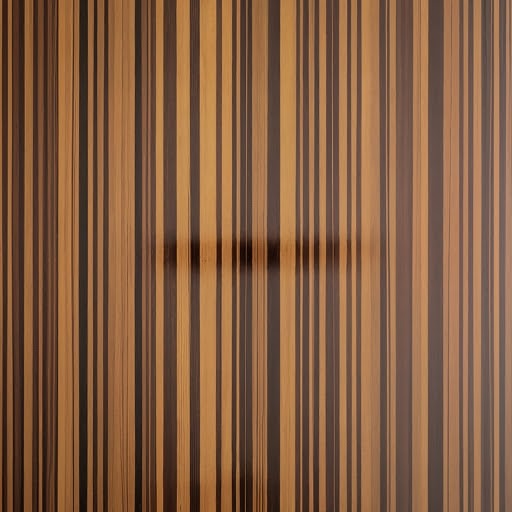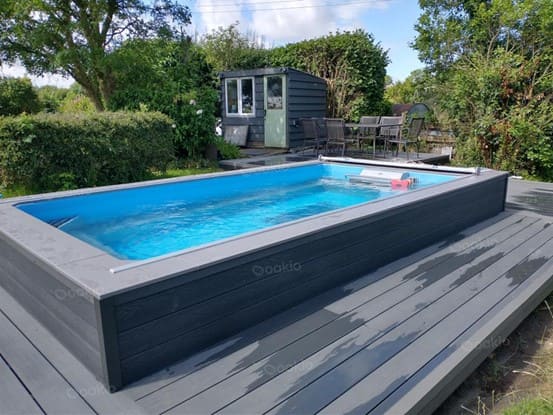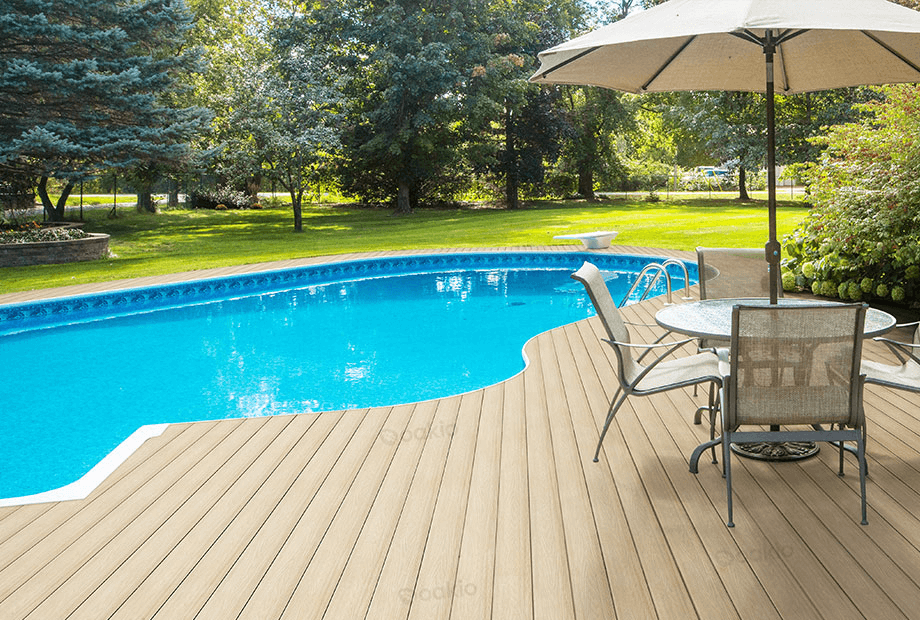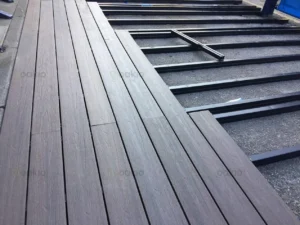PVC vs. Composite Decking: Choosing the Best Decking Material
Are you planning to build a deck or upgrade your current one? One of the most critical decisions you’ll face is selecting the right decking material. In this guide, we’ll delve into the benefits and differences between PVC decking and composite decking, helping you make an informed choice. We’ll also explore capped manufactured decking and discuss which option might be better for you.
Exploring PVC Decking: Pros and Cons
PVC decking, short for polyvinyl chloride decking, is a popular choice for many homeowners due to its durability and low maintenance. But what exactly makes PVC decking stand out?

First, let’s talk about the composition. PVC decking is made entirely of synthetic plastic, which means it’s highly resistant to moisture, insects, and rot. This makes it an excellent choice for areas with high humidity or frequent rainfall. Imagine never having to worry about your deck warping or splintering again—that’s the promise of PVC decking.
Moreover, PVC decking is incredibly low maintenance. Since it doesn’t absorb water, it doesn’t require sealing, staining, or painting. A simple wash with soap and water is enough to keep it looking fresh and clean. This is a significant advantage for busy homeowners who want to enjoy their deck without spending hours on upkeep.
Another benefit is its resistance to fading and staining. PVC decking typically comes with UV protection, ensuring that your deck will maintain its color even after prolonged exposure to the sun. And since it’s non-porous, spills and stains can be easily wiped away without leaving a mark.
However, PVC decking isn’t without its drawbacks. One of the main concerns is its cost. PVC decking tends to be more expensive upfront compared to other materials. Additionally, some people find that PVC decking can feel and look less natural than wood or composite options. It can also get quite hot under direct sunlight, making it uncomfortable to walk on barefoot during the summer.
Despite these cons, PVC decking remains a strong contender for those seeking a durable, low-maintenance decking solution. Its long lifespan and minimal upkeep make it a worthwhile investment for many homeowners.
Understanding Composite Decking: Features and Advantages
Composite decking is another popular option, known for blending the best qualities of wood and plastic. Let’s dive into what makes composite decking a fantastic choice, with a special focus on Oakio composite decking.
Composite decking is made from a mix of wood fibers and recycled plastic, providing a more natural look and feel compared to PVC decking. This blend gives composite decking its durability and resistance to the elements while also mimicking the appearance of real wood. If you want the aesthetic appeal of wood without the hassle of maintenance, composite decking is an excellent choice.
One of the standout features of composite decking is its eco-friendliness. By using recycled materials, composite decking helps reduce waste and promotes sustainability. Oakio composite decking, for instance, is known for its commitment to environmental responsibility, making it a great choice for eco-conscious homeowners.

Maintenance is another significant advantage of composite decking. Like PVC, composite decking is resistant to rot, insects, and moisture. It doesn’t need to be painted, stained, or sealed, which means less time spent on upkeep and more time enjoying your deck. Regular cleaning with soap and water is usually enough to keep it looking great.
Durability is also a key factor. Composite decking is designed to withstand the elements, resisting fading, staining, and scratching. Oakio proshield composite decking, in particular, offers excellent durability and comes with a range of color options and finishes to suit any style.
However, composite decking can also be more expensive than traditional wood decking. While the initial investment might be higher, the reduced maintenance costs and long lifespan can make it more cost-effective in the long run.
In summary, composite decking, especially from brands like Oakio, offers a beautiful, durable, and eco-friendly decking solution that requires minimal maintenance. Its natural appearance and resistance to the elements make it a popular choice for many homeowners.
Delving into Capped Manufactured Decking: The Hybrid Solution
Capped manufactured decking represents the next evolution in decking materials, combining the best features of PVC and composite decking. But what exactly is capped manufactured decking, and why might it be the right choice for you?
Capped decking is essentially composite decking with an added layer, or “cap,” of PVC. This cap provides extra protection against the elements, enhancing the durability and longevity of the deck. Think of it as a hybrid solution that offers the best of both worlds.
One of the primary benefits of capped manufactured decking is its enhanced resistance to moisture and UV rays. The PVC cap acts as a shield, preventing water from penetrating the deck and protecting it from sun damage. This means your deck will be less prone to fading, staining, and mold growth, keeping it looking new for longer.
Additionally, capped decking is highly scratch-resistant. The durable outer layer helps prevent scratches and dents, making it an ideal choice for high-traffic areas or homes with pets and children. It also resists staining, so accidental spills won’t leave a lasting mark.
Maintenance is straightforward, much like with pure PVC or composite decking. A simple cleaning with soap and water is usually all that’s needed to maintain its appearance. The protective cap also means you won’t need to worry about sealing or staining the deck, saving you time and effort.
Cost-wise, capped manufactured decking tends to fall in between PVC and composite decking. While it might be more expensive than traditional composite decking, the added durability and lower maintenance requirements can justify the higher initial investment.
In conclusion, capped manufactured decking offers a versatile and durable option for homeowners looking for a low-maintenance, long-lasting decking solution. Its blend of composite core and PVC cap provides exceptional protection and aesthetic appeal, making it a top choice for many.

PVC vs. Composite Decking: Which Decking is Better?
So, which is better: PVC vs. composite decking, or even capped manufactured decking? The answer depends on your specific needs and preferences.
If you prioritize low maintenance and durability, PVC decking might be the way to go. Its resistance to moisture, insects, and rot, coupled with minimal upkeep, makes it an excellent choice for busy homeowners. However, if you prefer a more natural look and feel, composite decking is likely a better fit. It offers the aesthetic appeal of wood with the added benefits of durability and low maintenance.
Oakio composite decking products stands out in this category. It combines recycled wood fibers and plastic to create a sustainable, durable, and beautiful decking option. Oakio’s commitment to environmental responsibility and high-quality materials makes it a standout choice for eco-conscious homeowners.
Capped manufactured decking, on the other hand, offers a hybrid solution. It combines the best features of both PVC and composite decking, providing enhanced durability and resistance to the elements. If you’re looking for a deck that can withstand heavy use and harsh conditions, capped manufactured decking is a strong contender.
When considering deck repair costs, both composite and capped manufactured decking tend to require less maintenance and fewer repairs over their lifespan compared to traditional wood decking. This can translate to significant savings in the long run.
Ultimately, the choice between PVC vs. composite decking (or capped manufactured decking) comes down to your priorities. Do you value the low maintenance and durability of PVC, the natural look and eco-friendliness of composite, or the enhanced protection of capped manufactured decking? Each option has its unique benefits, and understanding these can help you make an informed decision.
In conclusion, whether you choose Oakio composite decking for its eco-friendly benefits and natural look, or another type of decking for its specific advantages, you’re investing in a material that will enhance your outdoor space for years to come. Make sure to consider your lifestyle, aesthetic preferences, and maintenance expectations to find the perfect decking solution for your home.
Trending Reading
What Are the Differences Between the WPC Board and PVC Board?
[2024 Update] How Long Does WPC Decking Last?













